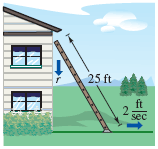
Natalie G.
asked • 07/01/21solving question
A ladder 25 feet long is leaning against the wall of a house. The base of the ladder is pulled away from the wall at a rate of 2 feet per second.

(a) What is the velocity of the top of the ladder when the base is given below?
7 feet away from the wall
ft/sec
15 feet away from the wall
ft/sec
20 feet away from the wall
ft/sec
(b) Consider the triangle formed by the side of the house, ladder, and the ground. Find the rate at which the area of the triangle is changing when the base of the ladder is 20 feet from the wall.
ft2/sec
(c) Find the rate at which the angle between the ladder and the wall of the house is changing when the base of the ladder is 20 feet from the wall.
rad/sec
2 Answers By Expert Tutors
Raymond B. answered • 07/01/21
Math, microeconomics or criminal justice
hypotenuse squared = sum of squares of the other sides
h^2 = b^2 + a^2
2hh' = 2bb' + 2aa'
hh' = bb' + aa' h'=0
aa' = -bb' b= 7, b' =2
a = sqr(25^2 - 7^2) = sqr(625-49) = sqr(576) = 24
a=24
a' = -7(2)/24 = -14/24 = -7/12 ft/sec = rate of change of the top of the ladder to the ground
for b=15
a' = -15(2)/24
0 = -30/24 =-3/2 ft/sec = rate of change of the top of the ladder
for b=20
a' = -20(2)/15 = -8/3 ft/sec
It's moving faster for larger base length
as the ladder base length approaches the length of the ladder
a' =-2(25/0) = -infinity

Yefim S. answered • 07/01/21
Math Tutor with Experience
Let (0,y) is atop and (x, 0) bottom. Then x2 + y2 = 625 (1). We differentiate this equation by time:
2xdx/dt + 2ydy/dt = 0, or xdx/dt + ydydt = 0 (2); dx/dt = 2 ft/sec
(a) x = 7 ft; then from (1) 49 + y2 = 625; y = 24 ft.
Now fronm (2) we have: 7·2 + 24dy/dt = 0; dy/dt = - 7/12 ft/sec (y decreasing)
x = 15 ft then from (1) y = 20 ft and 15·2 + 20dy/dt = 0; dy/dt = - 1.5 ft/sec (y decreasing)
x = 20 ft then from (1) y = 15 ft and 20·2 + 15dy/dt = 0; dy/dt = - 8/3 ft/sec (y decreasing)
(b) Area A = xy/2; dA/dt = ydx/dt/2 + xdy/dt/2 = 15·2/2 + 20(- 8/3)/2 = 15 - 80/3 = - 35/3 ft2/sec (A decreasing)
(c) tanθ = x/y; sec2θdθ/dt = (ydx/dt - xdy/dt)/y2; dθ/dt = (ydx/dt - xdy/dt)cos2θ/y2 =
(15·2 - 20(- 8/3))(15/25)2/152 = 0.4 rad/sec
Still looking for help? Get the right answer, fast.
Get a free answer to a quick problem.
Most questions answered within 4 hours.
OR
Choose an expert and meet online. No packages or subscriptions, pay only for the time you need.





Andrew D.
07/01/21